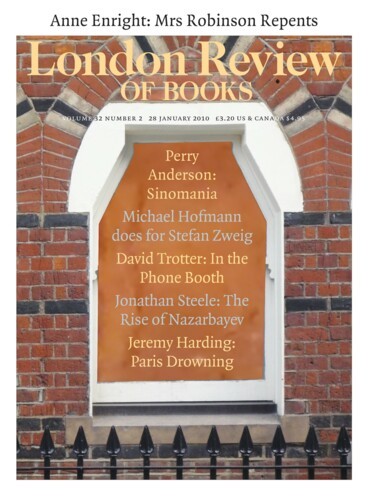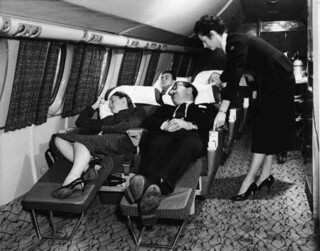Old posters romance journeys. The couple on deck watch the moon rise over a tropical sea. A castle on a rock fills the window of a train. A landscape unwinds before an open touring car that eats up miles of empty road. A flying boat drifts down at sunset to land on the Nile.
Neither the posters nor the reality are like that now. Travel advertisements still show destinations – a palm-fringed beach, a café in the old town – but not what you might look at from the airliners that take you there. Which is fair enough. At 30,000 feet the night sky or an island of cloud is often all you can see, even from a window seat; high-speed trains turn all but distant landscape into a blur; the new cruise ships are too big for small harbours, and big ports are unglamorous container terminals; country roads are rarely empty. So what is shown now, instead of the country that lies between home and destination, is people, better groomed than anyone should be after ten hours in the air, sleeping sweetly or taking drinks from smiling cabin staff.
Well-appointed cabins are not a new thing. A version of what you find when you turn left coming aboard a 747 is there in Eliot’s 1930s description of the overnight express:
The berth is very neat with a newly folded sheet
And there’s not a speck of dust on the floor.
There’s every sort of light – you can make it dark or bright;
There’s a handle that you turn to make a breeze.
There’s a funny little basin you’re supposed to wash your face in
And a crank to shut the window if you sneeze.
Well, there’s no crank on the plane, and you do share the basin. But more general aspects of travel have changed profoundly. Leaving a country by boat or train was a ceremony, now it’s a process. Friends on the wharf held streamers, people sang ‘Now Is the Hour’. Trains had windows that opened; you could lean out of them and wave.
The long, high-roofed atriums of modern air terminals constitute a building type as recognisable as the train shed of a 19th-century railway station, but here if you want to blow a goodbye kiss you must do it long before the plane trundles off and joins the queue for take-off. Modern long-distance air travellers, sequestered from their friends, become items on an electronic audit trail. At each stage of the passage from check-in and passport control to baggage scan and body frisk their progress is registered, ticked off, approved. Their view of the plane itself is usually, at best, a glimpse of its huge nose seen through one of the high windows by the boarding gate. Once they have entered the enclosed air bridge that takes them to the cabin door they have, apart from the odd glimpse of a wing, seen the last of the outside of it. The stairways on which presidents, sports teams and popes stand and wave before they step down from their aircraft can seem, to anyone used to modern passenger management, as ceremonious and anachronistic as the horse-drawn carriages of royalty.
Last month, setting out for New Zealand, with very nearly 50 expatriate years and many trips home behind us, we turned left for the first time at the door of the 747. For once we would lie down, not sit up, would con richer menus and wine lists, and not have to climb over someone else when we needed a pee.
All very luxurious, but a reminder that all classes are now denied the freedoms of old-fashioned travel – the promenade deck, the observation car, the windows angled to look down – that made airships viewing platforms. Anyone who has spent time in a public hospital ward will have a sense of déjà vu on a long-haul flight. One is institutionalised: first given food and a drink, then – this time – with seats turned into beds, strapped in under a duvet. It is not that you are forced to lie down, just that when the lights are dimmed and the blinds on the windows closed it seems like time for sleep. We left Hong Kong at local breakfast time, but even those who boarded the plane there tucked themselves in and dozed off. Not many of the little screens that give blurred versions of movies were lit up. Few reading lights were on.
I remember making this journey at other times and looking at the Himalayas and the red Australian desert or, when taking the western route, at the Canadian tundra and the Hoover dam. Try to look at the view now, I thought, and the ward sister will come round and gently pull down the blind. I wouldn’t have been surprised if she had been there to take my blood pressure when, an hour or so from landing, the cabin lights came up and the hard white light reflected from clouds below was allowed to shine through. Breakfast was on its way.
This blast of light was a prelude to the bright, bright light of home. It is not just imagination that tells you there is more of the stuff out there. Fugitive magenta and yellow inks on the spines of quite new books have faded, leaving them all pale blue. Dermatologists advertise mole-mapping services. The vegetation is thick, as though each exposed square inch was able to turn more carbon and oxygen and water into leaves and wood than under milder skies.
You see foliage threshing and billowing in the wind on the steep Wellington hills, like a speeded up movie of dark green storm clouds. I watched them from the deck of the Picton ferry, keeping track of familiar places which diminished and disappeared as the ship crossed the harbour and headed out past the heads before turning west across Cook Strait. The last time I left the city by sea was in 1960 on a passenger ship taking home the relatives of Dutch immigrants. (Sausage and cheese for breakfast, Dutch Scrabble sets.) That departure for Europe took place while a few people still called England ‘home’. The weeks at sea were a limbo separating past and future. The jet lag that now follows semi-circumnavigation feels like a residual twitch, a sublimated memory of that time at sea. From the ferry I watched gannets and shearwaters, not the flying fish we saw in the tropics, but in its small way this was a voyage, unlike the sedated hours in the aircraft, as close as the taking of one’s physical being halfway round the world could be to an electronic bank transfer.
Coming back over Cook Strait we flew, but at no great height, looking down at white-topped waves, oyster farms, fishing boats and ferries. It was a small plane – boarded by steps. The train we took up the length of the North Island felt small too. New Zealand railways run on a narrow gauge and the main trunk line is sometimes single-track, passing over high viaducts. The snow-capped volcanoes gleamed, the rivers in the gorges glittered far below. There was even an observation platform where you could stand, unable to hear what anyone was saying through the noise of the wind and of wheels on rails.
The return journey offered no news of where we were or what was around us until, during the last ten minutes of the flight, London passed landmark by landmark below us – waiting, it turned out, for the snow.
Send Letters To:
The Editor
London Review of Books,
28 Little Russell Street
London, WC1A 2HN
letters@lrb.co.uk
Please include name, address, and a telephone number.


